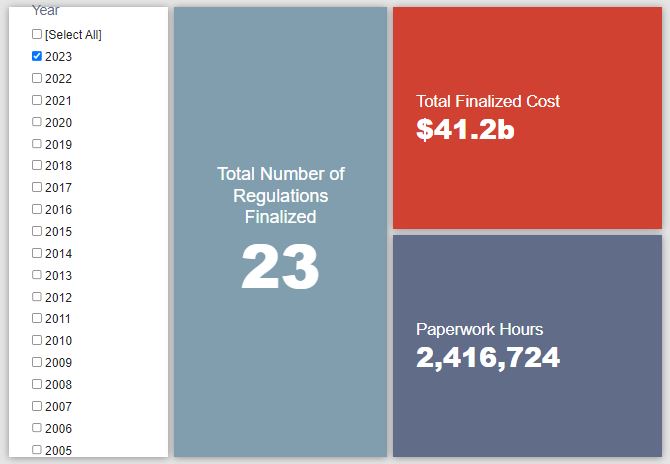Week in Regulation
February 21, 2023
Regulatory Impacts Take a Dip
Starting in the middle of last November, each successive week has seen regulatory activity with economic effects totaling in the billions of dollars. Last week saw that streak come crashing down like an aircraft of indeterminate origin. Across the eight rulemakings with some measurable economic impact, none exceeded even the $100 million threshold in terms of net costs or savings. The hodgepodge of relatively minor actions covered such topics as conflicts of interests in securities transactions, modernizing housing assistance programs, and “omitting food” expenses from certain Social Security calculations. Across all rulemakings, agencies published $39.6 million in total costs but cut 30,711 annual paperwork burden hours.
REGULATORY TOPLINES
- Proposed Rules: 36
- Final Rules: 57
- 2023 Total Pages: 10,443
- 2023 Final Rule Costs: $41.2 billion
- 2023 Proposed Rule Costs: $17.1 billion
NOTABLE REGULATORY ACTIONS
As noted above, last week saw a handful of actions pushing the week’s overall totals in different directions. A Securities and Exchange Commission proposal regarding “Prohibition Against Conflicts of Interest in Certain Securitizations” brought roughly $82 million in expected administrative costs. That cost estimate, however, was tempered by $52 million in savings from a Department of Housing and Urban Development (HUD) rule focusing on “Housing Opportunity Through Modernization Act of 2016: Implementation of Sections 102, 103, and 104.” The downward movement in the week’s paperwork total came from the Social Security Administration proposing to eliminate its requirement that Supplemental Security Income applicants and recipients report food expenses as a part of their eligibility calculations. The agency expects this change to “result in a burden reduction of one minute per response per affected form” that adds up to 95,668 hours saved in the aggregate.
TRACKING THE ADMINISTRATIONS
As we have already seen from executive orders and memos, the Biden Administration will surely provide plenty of contrasts with the Trump Administration on the regulatory front. And while there is a general expectation that the current administration will seek to broadly restore Obama-esque regulatory actions, there will also be areas where it charts its own course. Since the AAF RegRodeo data extend back to 2005, it is possible to provide weekly updates on how the top-level trends of President Biden’s regulatory record track with those of his two most recent predecessors. The following table provides the cumulative totals of final rules containing some quantified economic impact from each administration through this point in their respective terms.
![]()
With such limited action last week, there was very little movement in the Biden Administration’s final rule totals. Net costs declined by $34 million while paperwork stood pat. The HUD rule discussed above was the primary reason for this decrease. The other administrations were similarly stagnant. The most notable movement was a $38 million uptick in Obama-era costs. The main driver of this relatively modest increase was an Environmental Protection Agency rule regarding emissions standards for facilities that process gold ore.
THIS WEEK’S REGULATORY PICTURE
This week, the Department of Transportation (DOT) released the final version of its guidelines for electric vehicle (EV) charging stations installed and deployed under the Bipartisan Infrastructure Law (BIL).

Source: Photo by CHUTTERSNAP on Unsplash
One of the main themes of the BIL was to spur greater support for less carbon-intensive technologies, such as EVs. Under the new law, DOT expects there to be roughly half a million EV chargers across the country over the next decade. Given the relatively nascent and still-developing nature of charger technology, however, the BIL directs DOT to establish some baseline standards for the coming national network of charging stations. The purpose of this is to give the average consumer a reasonable idea of what they can expect at a given station as they traverse different states, much as one currently has basic expectations for any gas station they encounter.
DOT focuses on the following six areas of charging station installation and operation:
- “Installation, operation, and maintenance by qualified technicians of EV infrastructure” – Outlines some of the minimum training requirements DOT expects relevant staff to meet to operate a charging station.
- “Interoperability of EV charging infrastructure” – Makes sure that a given station’s interface is able to service a wide array of EVs across different makes and models.
- “Traffic control devices and on-premise signs acquired, installed, or operated” – Provides a uniform set of signage and instruction parameters to clarify process for consumers.
- “Data requested related to EV charging projects subject to this rule, including the content and frequency of submission of such data” – Sets how state authorities report data on charger deployment back to DOT in order for the department to build out its public database on EV charger coverage.
- “Network connectivity of EV charging infrastructure” – Requires stations to have some broader communication network capacity in order to more easily monitor the charging grid’s integrity.
- “Information on publicly available EV charging infrastructure locations, pricing, real-time availability, and accessibility though mapping applications” – Establishes the framework for how stations communicate information “such as location, connector type, and power level” to potential consumers.
In terms of direct economic impact, DOT finds that “many of the costs and benefits in the proposed rule are difficult to quantify.” This is understandable since the issues involved in calculating (i.e., the volume of stations per state, the discrepancies between current state rules versus this national rule, etc.) are highly variable. Additionally, DOT does not expect these new standards to present a massive change in practice for relevant stakeholders, noting “that States and other designated recipients would likely choose the same requirements that are found in this final rule.”
TOTAL BURDENS
Since January 1, the federal government has published $58.3 billion in total net costs (with $41.2 billion in new costs from finalized rules) and 8.1 million hours of net annual paperwork burden increases (with 2.4 million hours in increases from final rules).











